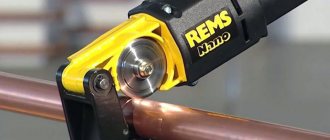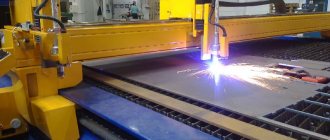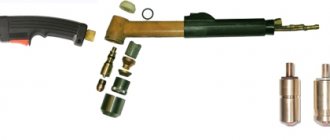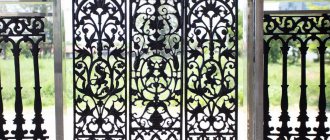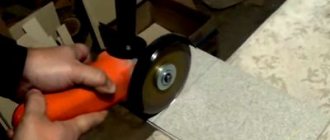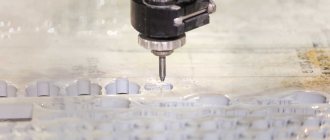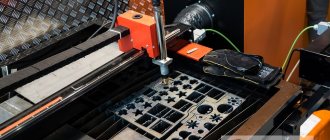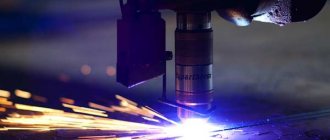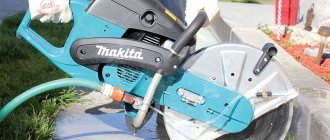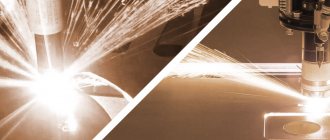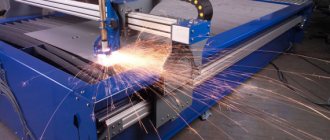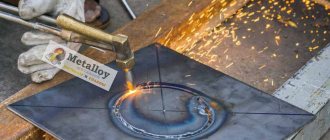12.05.2020
Plasma cutting of metal is a process during which equipment generates a compressed plasma arc that melts the material and removes the melt from the cut zone. This technology is considered the most universal in terms of the metals to be cut, the range of thicknesses and cutting speeds. But all these possibilities are provided subject to the choice of a high-quality and productive device.
Operating principle of the installation
Structurally, equipment for plasma separation cutting of metals includes the following components:
- Power source - serves to supply current and voltage to excite the pilot and cutting arc. It can have a steeply falling current-voltage or constant current characteristic.
- Plasma torch is a device for generating and stabilizing a plasma jet. It has a complex structure, the main elements of which are a nozzle, a cathode, and a swirler.
- Cooling system - designed to cool cables and plasma torch, which are subject to excessive heating. Installations with a power of 100 A or more are equipped with water cooling, less powerful devices with air cooling.
- A reproduction system or CNC (numerical control) is a complex that ensures automatic movement of a support with a plasma torch along a contour specified by a special program.
- Cutting table (relevant for automatic CNC machines) - is a steel flooring for placing rolled metal that will be cut.
Figure 1. Approximate diagram of equipment for automatic plasma cutting
The principle of operation is the formation of plasma, which the plasmatron forms into a directed jet. A direct plasma arc occurs when current flows from the cathode (non-consumable electrode) to the anode (steel billet). Due to the high energy density and high temperature (up to 5000-30000 °C), the plasma expands, which leads to its high-speed (up to 3 km/sec.) outflow towards the rolled metal.
A plasma jet is formed by a small hole in the nozzle and, thanks to the directed effect, instantly heats the metal to the melting point, blowing it out of the cutting zone.
Figure 2. How the devices work
The sequence of working with the settings is as follows:
- Preparation - laying a metal sheet on a work table, to which a “positive” wire connected to a power source is connected. The “negative” wire is connected to the electrode in the plasmatron. Checking the functionality of equipment, integrity of hose packages, etc.
- Ignition of the pilot arc by supplying high voltage and initiation of the cutting arc when the pilot arc touches the material being cut.
- Burning of metal and movement of the plasma torch along a given contour with a constant speed and distance between the workpiece and the nozzle.
Photo 3. Plasma jet separation cutting process
Principle of operation
Result of the plasmatron operation
The principle of operation of the plasmatron is as follows. A flow of high-temperature ionized air is created, the electrical conductivity of which is equal to the electrical conductivity of the workpiece being cut (i.e., the air ceases to be an insulator and becomes a conductor of electric current).
An electric arc is formed, which locally heats the workpiece: the metal melts and a cut appears. The plasma temperature at this moment reaches 25,000 – 30,000 °C. Particles of molten metal appearing on the surface of the workpiece being cut will be blown away from it by the air flow from the nozzle.
Technology
The technology of plasma cutting of metal can be briefly described as follows. All types of metals up to 220 mm thick can be treated with plasma.
The effect appears after the ignition of the plasma-forming gas when a spark is formed in the electric arc circuit (between the tip of the nozzle and the non-consumable electrode. The spark ignites the gas flow, and here it is ionized, turning into controlled plasma (with an extremely high exit speed of 800 and even 1500 m/s ).
Interesting: Plasma cutting of concrete - technology features
In the outlet hole, due to the narrowing, the flow of the plasma-forming carrier accelerates. A high-speed plasma jet allows you to obtain an outlet temperature of about 20,0000C. A narrowly directed jet of thousands of degrees literally melts the material in the targeted area of influence, heating around the treatment site is insignificant.
The plasma-arc method is used to close the treated surface into a conductive circuit. Another type of cutting (plasma jet) - works in the presence of third-party (indirect) formation of a high-temperature component in the working circuit of the plasma torch. The metal being cut is not included in the conductive circuit
Plasma jet cutting
Plasma jet cutting of workpieces is used for processing materials that do not conduct electric current. When cutting with this method, the arc burns between the forming tip of the plasmatron and the electrode, and the object being cut does not participate in the electrical circuit. A plasma jet is used to cut the workpiece.
Plasma arc cutting
Conductive materials are subjected to plasma arc cutting. When cutting using this method, the arc burns between the workpiece being cut and the electrode, its column is combined with the plasma jet. The latter is formed due to the supply of gas, its heating and ionization. The gas blown through the nozzle compresses the arc, gives it penetrating properties and ensures intense plasma formation. The high temperature of the gas creates the highest flow rate and increases the active effect of the plasma on the melting metal. The gas blows metal droplets out of the cutting area. To activate the process, a direct current arc of direct polarity is used.
Plasma arc cutting is used for:
- production of parts with straight and shaped contours;
- cutting holes or openings in metal;
- production of blanks for welding, stamping and machining;
- processing of forging edges;
- cutting pipes, strips, rods and profiles;
- casting processing.
Types of plasma cutting
Depending on the environment, there are three types of plasma cutting:
- simple. This method involves using only air (or nitrogen) and electric current;
- with protective gas. Two types of gas are used: plasma-forming and protective, which protects the cutting area from environmental influences. As a result, the quality of the cut improves;
- with water. In this case, water performs a function similar to a shielding gas. In addition, it cools the components of the plasma torch and absorbs harmful emissions.
Plasma cutting based on these principles ensures not only high-performance production, but also completely fireproof: the materials used in the technology are not flammable.
Video
Watch videos that clearly explain how plasma cutting works:
Operating principle of air plasma cutting of metal
Air plasma cutting: what is the principle of implementation based on. The cutting plasma is a heated gas with a high electrical conductivity. It is also called ionized. Plasma is generated by a special arc element. This cutting method is commonly called plasma cutting.
A conventional arc is compressed by a plasma torch. Ionized gas is blown into it, with the help of which it can generate hot air. It is capable of processing using elevated temperatures. The metal is cut, melting at the same time.
Metal processing occurs thanks to both a plasma arc and a jet. In the first option, the metal product is directly affected, in the second - indirect. The most common and effective cutting method is direct action. For a material that does not have electrical conductivity (usually non-metallic products), the indirect influence method is used. In any of the options, the material being cut does not lose its state of aggregation and its structure is slightly subject to deformation.
Interesting: Plasma arc metal cutting technology
Working principle of a plasma cutter
A plasma torch is a technical device that creates an electrical discharge between an electrode (cathode) and the surface of a workpiece (anode), this occurs in a gas flow that forms plasma.
The principle of operation of the device: water or gas is used for cooling, plasma-forming gas is used to produce plasma. The gas flow entering the chamber is heated to high temperatures and then ionized, thereby acquiring the properties of plasma. Plasma-forming gas and cooling gas are supplied to various channels of the plasmatron . When power is applied, a so-called auxiliary discharge is formed between the cathode and the nozzle; visually it can be seen as a small torch.
The main (working arc) is formed when the secondary discharge touches the surface being processed, which in this case acts as an anode (plus). Stabilization of the discharge can be carried out by a magnetic field, water or gas; often the stabilizing gas is also plasma-forming. After this, material can be cut, coated, welded, surfaced, or even mined by breaking up rocks.
Conventionally, the design of a plasma torch can be represented as several main elements:
- insulator;
- electrode;
- nozzle;
- mechanism for supplying plasma-forming gas;
- arc chamber.
Design and principle of operation of a plasmatron with a combined nozzle and channel
A special feature of a plasmatron using air plasma cutting is the combination of a channel and a nozzle. The air passes through the nozzle channel to the outside. The operating principle is similar; when power is supplied, an auxiliary discharge is formed between the cathode and the nozzle. The air, twisted in a spiral, stabilizes and compresses the column of the working discharge. It also prevents the electric arc from touching the walls of the nozzle channel.
Types of plasma torches
Plasmatrons can be divided into three global types
- electric arc;
- high frequency;
- combined.
Devices operating on the basis of an electric arc are equipped with one cathode, which is connected to a DC power source. For cooling, water is used, which is located in the cooling channels.
The following types of electric arc devices can be distinguished:
- with a straight arc;
- indirect arc (indirect plasma torches);
- using an electrolytic electrode;
- rotating electrodes;
- rotating arc.
Automatic: operating principle
The automatic plasma cutting machine has:
- Remote Control,
- plasma torch
- work table for workpieces.
Automatic cutting machine (China).
Photo source: ru.made-in-china.com On the control panel, preset programs are adjusted if cutting deviates from the set parameters. For quick corrections during operation and selection of optimal cutting conditions.
An electric current is passed through a sheet installed on the desktop. A primary electric arc runs between the surface of the sheet and the plasmatron. In which compressed air is heated to the state of plasma. The primary arc is hidden in a hot ionized jet, which cuts the metal.
Cutting starts from the middle or from the edge. The more often the arc is interrupted and a new spark is ignited, the shorter the resource of the nozzle and cathode becomes. A competent automatic cutting operator selects cutting modes according to the table and based on specific conditions (metal thickness, nozzle diameter). Thanks to this, you can achieve significant cost reductions. At the end of the operation, the machine will independently notify the operator, turn off and remove the plasma torch from the material.
Interesting: What is plasma pipe cutting
Application of settings
Plasma equipment for cutting metal with a directed plasma jet is widely used in various industries:
- automobile, ship, aircraft construction;
- construction industry;
- metalworking and production of metal structures;
- metallurgy;
- heavy engineering, etc.
Photo 4. Plasma cutting in a workshop environment
The devices are also often used in small auto repair shops and forges. Inverters are often used even in everyday life, since they are effective devices for separating cutting of structural steels and non-ferrous metals.
Types of machines
Machines for plasma cutting of metal can be divided into several categories:
- Manual devices - for cutting rolled metal manually, where the entire working process (the speed of movement of the plasma torch, the gap between the nozzle and the workpiece) is controlled by a person.
Photo 6. Inverter device for manual plasma cutting
- Portable sheet slitters – for straight cutting in one direction only. They are usually equipped with a guide along which the carriage with the cutter moves.
Photo 7. Installation for straight-line cutting of sheets “Gran”
- Pipe cutting devices are special machines for circular cutting and chamfering during the installation of main pipelines. They are self-propelled carts that move around a circle using a drive chain.
Photo 8. Orbita-M pipe cutting machine
- Automatic CNC machines are fully automated installations for straight and shaped cutting. The operating parameters and the contour of movement of the support with the cutter are set automatically by the program depending on the thickness and grade of the metal. Available in the form of portal, portal-hinged, hinged and portable machines.
Photo 9. Gantry CNC plasma cutting machine
Design features
Hand-held plasma equipment consists of several technological elements that ensure its functionality.
One of the main elements is the plasmatron itself, the functioning of which is provided by a specified power source with certain operating parameters.
Also, a hand-held plasma device must include a set of cables and special hoses with the appropriate cross-section.
Additionally, the operation of the plasma device is ensured by a universal compressor. It is worth noting that the plasma torch, which acts as a cutter, has a rather complex design.
It consists of the nozzle itself and a special electrode, between which an insulator with high heat resistance is specially arranged.
It is in the plasmatron that the arc of electricity is converted into thermal energy of the plasma. The speed, as well as the shape of the plasma flow, is controlled by a nozzle, which has a complex design.
When working with a manual plasma machine, the operator independently controls the evenness of the cut line.
When working with a hand-held plasma device, operator experience is of great importance.
IMPORTANT TO KNOW: Description of waterjet cutting machines
Since a person constantly holds the working apparatus suspended, involuntary movements are possible, which can lead to the appearance of defects and a decrease in the quality of the cutting performed.
An inexperienced operator can make a cut not only uneven, but also with sagging and traces of jerks.
To prevent this from happening, a variety of additional devices are produced in the form of stops and stands.
When using them, even an inexperienced operator obtains the cut as smooth and high-quality as possible.
A manual unit for plasma cutting of metals offers enormous functionality in the field of processing metals of various thicknesses and configurations.
You can see how the process of cutting metals using a manual plasma device is performed in the video below.
Video:
Cost of metal cutting machines
The price of equipment for separation plasma cutting of metal depends on operating parameters and functionality:
- type – manual or automatic with CNC;
- maximum operating current;
- PV (on duration) – household (up to 60%), semi-professional (60 to 80%), professional (80-100%).
The category of budget devices includes inverter devices for manual cutting with a maximum duty cycle of 60%. Models designed for more intensive use belong to the middle price category. CNC machines are the most expensive; they are usually equipped with large industrial enterprises where mass production of products is established. Therefore, it is important to initially determine the principles for the selection and future operation of machines.
Pros and cons of plasma cutting
When compared with other methods of cutting sheet metal, plasma technology has some advantages.
The first thing to note is the high performance.
From this follows the optimal price of the product, which consists of several components - energy saving, optimal use of metal and high precision of products.
Video:
Disadvantages include limitations on the thickness of the processed metal. The disadvantages also include the price of some CNC machines.
Despite these limitations, plasma cutting is used both for industrial purposes and in the domestic sphere.
The best manufacturers of plasma equipment
Plasma cutting is considered one of the most high-tech cutting technologies, so the equipment is in great demand. It is produced by both foreign and domestic manufacturers. The cost of imported machines is very high, so most firms and large enterprises give preference to Russian brands.
One of the leading domestic companies in the development and production of plasma cutting units is PURM LLC. It produces all types of equipment - from manual inverter and transformer devices to pipe cutters and fully automated machines with numerical control.
Video about using the settings:
Advantages of PURM brand machines:
- focus on harsh operating conditions;
- high precision and cleanliness of the cut;
- minimal energy consumption;
- simple maintenance and operation.
Operating principle of a plasma cutter
Cutting metal alloys and other materials using plasma is performed on a special installation called a plasma cutter.
It should be recalled that plasma is one of the forms of existence of matter. In the human environment, material objects appear in a solid, liquid or gaseous state.
Plasma is the fourth state, which is characterized by high temperature.
A plasma cutting machine creates a stream of high-temperature ionized air, which cuts the workpiece.
The operating temperature of this stream reaches values from 5000 to 30000 degrees.
The installation consists of the following elements:
- power supply;
- compressor;
- plasmatron.
The power source is either a transformer or an inverter. Using a transformer, you can cut workpieces of large thickness.
It withstands power surges without loss. At the same time, it has a lot of weight, low efficiency and a high price.
The inverter is cheaper, more economical and much lighter. An inverter device has a higher efficiency compared to a transformer.
The compact design allows the use of inverter installations in CNC complexes, inconvenient and hard-to-reach places.
Today, the industry produces a wide range of inverter installations for cutting metal using plasma.
A compressor supplies air or a certain gas to the plasma cutter.
IMPORTANT TO KNOW: 2 ways to sharpen metal scissors
The air is supplied under high pressure, which provides a vortex shape of the jet.
The plasmatron is the main element of the plasma cutter and is a cutter that consists of the following elements:
- cap;
- cooler;
- nozzle;
- electrode.
When voltage is applied and the arc is ignited, an air flow occurs, which has a high degree of ionization.
The presence of ions transforms air from an insulator into a conductor of electric current. In this case, an electric arc is formed.
Under the action of the arc, the workpiece is locally heated, the metal melts and a cut is formed.
How to choose a metal cutting machine?
When choosing a plasma cutting machine, you initially need to decide on the following:
- The proposed work is only straight cutting or with the possibility of shaped cutting.
- Productivity – manual or automatic cutting, CNC, photocopying.
- The grade and maximum thickness of the material being processed - the power and what gas will be used (compressed air, nitrogen, mixtures based on argon and hydrogen or other gaseous substances) depend on this.
You also need to determine the operating characteristics of the device. The main ones include current strength, since it determines the range of cut thicknesses - the higher this indicator, the thicker the metal can be cut.
PV (on duration) characterizes the maximum loads that the equipment can withstand - i.e. its operating time without interruptions for cooling. Indicated as a percentage - 80% duty cycle means that out of a 10-minute operating cycle, the device can continuously operate at maximum load for 8 minutes. If this indicator is exceeded, overheating and failure are possible.
Characteristics of the cutting process
Manual plasma cutting, which uses a hand-held plasma machine, can be classified as a heat treatment in which the material is melted.
In this particular case, the main cutting tool is a flow of low-temperature plasma under high pressure, which is formed due to some specific processes.
Plasma equipment used for operation necessarily has a special electrode, which, using a nozzle and working metal, creates an electric arc, the external temperature of which in some individual cases reaches several thousand degrees Celsius.
At a certain moment, a special gas begins to be supplied into the nozzle under high pressure, which causes the operating temperature to increase many times, and this, in turn, leads to ionization of the gas and, accordingly, its transformation into plasma, which is called low-temperature.
It should also be noted that ionization tends to increase when heated from the arc, and this makes the temperature of the gas flow even higher. The working flow itself glows brightly and becomes electrically conductive.
IMPORTANT TO KNOW: Applications and features of flameless cutting
A device used for metal processing using plasma is capable of locally heating a metal workpiece and melting it directly at the required cut location.
In order to obtain plasma, it is necessary to mix certain types of gases in certain proportions.
The basis is atmospheric air, which is mixed with oxygen, nitrogen, as well as hydrogen and argon. Plasma also contains water vapor.
To ensure that the nozzle does not melt during operation under the influence of high temperatures, it is specially cooled due to the flow of liquid or gas.
Of course, using a plasma cutting machine in everyday life is quite problematic, since certain operating conditions are required, but this equipment is installed in many industrial enterprises.
It is worth noting that the price of such a device is quite high and is simply not affordable for many home craftsmen.
Currently, such equipment is actively used in a variety of fields and makes it possible to obtain not only an even, but also a neat cut.
You can learn more about the capabilities of hand-held plasma cutting machines in the video below.
Video:
The most common car breakdowns
In practice, when operating plasma equipment, the following problems are more often encountered:
- Voltage drops exceeding the range specified by the manufacturer.
- Physical wear and tear of components and mechanisms, greatly exceeding the established service life of parts.
- Short circuits in the electrical network, which leads to failure of the main control boards.
However, all these breakdowns are eliminated, after which the machines can continue to operate in standard mode. The only thing is that you need to change consumables (cathode, nozzle) in a timely manner, which will ensure stable operation of the equipment and high quality of plasma cutting.
← Plasmatrons for cutting metal: design, types, selection rules Manual plasmatron: device, principle of operation and features →
